Geghard › Herodotus in Art » Origins and History
Articles and Definitions › Contents
- Geghard › Ancient History
- Herodotus in Art › Antique Origins
Ancient civilizations › Historical places, and their characters
Geghard › Ancient History
Definition and Origins
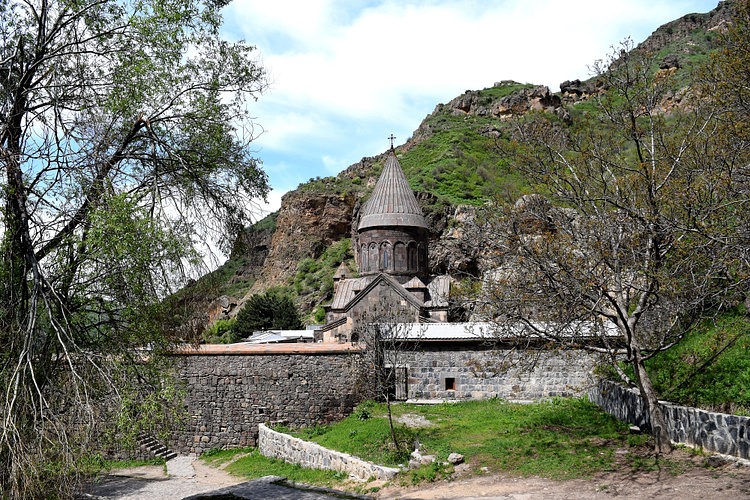
Geghard (Armenian: Geghardavank or "monastery of the spear") is a medieval monastery located in Armenia ’s Kotayk province, deep within the Azat Valley, which was built directly out of an adjacent mountain. Geghard is renown throughout Armenia for its medieval art and architecture, and local traditions associate the site with Saint Gregory the Illuminator (c. 257 – c. 331 CE) who came to the area to found a small Christian chapel in the 4th century CE. Geghard's name attests to the former presence of a spear that supposedly pierced the body of Jesus Christ while he was crucified. This is now kept at Echmiadzin Cathedral in Vagharshapat, Armenia. The complex was designated as a UNESCO World Heritage Site in 2000 CE.
HISTORY & GEOGRAPHY
Geghard is enveloped by tall cliffs along the Azat River, and the monastery is not too far from the strategic Ararat Plain.Located 30 km (19 mi) from Yerevan, the Geghard is quite near the Temple of Garni - Armenia's only surviving pagan temple- which is only 11 km (7 mi) down the Azat River. Geghard is additionally not too far from the ancient Armenian capital of Artashat and the medieval fortress of Kakavaberd. It is likely that the environs around Geghard were inhabited in prehistoric times, including by the Urartians between the 8th-6th centuries BCE. In pagan times, local inhabitants venerated a spring that emerged from the cave that today forms part of the monastery. It is for this reason that Geghard is sometimes referred to as "Ayvirank," which in Armenian means "Monastery of the Cave."
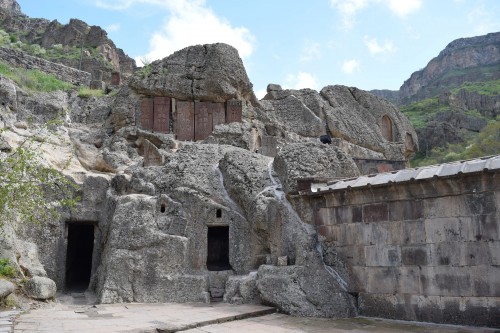
Geghard Monastery Cut from Rock
Over time, Ayvirank grew from being a small chapel into a monastic community. The monastery is attested by ancient and early medieval Armenian historians, although the remains of Ayvirank have not survived the ages. In the 8th and 9th centuries CE, Arab invaders pillaged Ayvirank, destroying unique manuscripts, libraries, and burning down the multiple religious edifices of which comprised the monastery. Although Ayvirank was ruined, in time, a new monastery would be rebuilt in its place: Geghard.
Inscriptions within the complex insinuate that construction on the main church of Geghard - Katoghike - ended around the year 1215 CE. This church was commissioned under the patronage of two Armenian princes: Zakharia and Ivan. However, it should be noted that the oldest inscriptions at the complex are located within the small Chapel of St Gregory, and they date to the 1170s CE. When Queen Tamar (r. 1184-1213 CE) reconquered much of Armenia from the Seljuk Turks and other Turkic tribes in the late 12th and early 13th centuries, she helped stimulate a brief golden age of artistic splendor and cultural production in both Armenia and Georgia. Geghard flourished, as a result, from c. 1200-1400 CE when it was a popular destination for Armenian and Georgian Christians. Mkhitar Ayrivanetsi and Simeon Ayrivanetsi - Armenian historians who pioneered innovative techniques in Armenian manuscript art - lived and worked at Geghard in the 13th century CE. Geghard was called the "monastery of the seven churches and the monastery of the forty altars" during its medieval heyday.
GEGHARD WAS CALLED THE "MONASTERY OF THE SEVEN CHURCHES AND THE MONASTERY OF THE FORTY ALTARS" DURING ITS MEDIEVAL HEYDAY.
Pilgrims came to Geghard mainly to see the sacred spear that touched Christ and was brought to the Caucasus by the Jude the Apostle (d. 70 CE). He is usually identified with Thaddeus and sometimes called "Jude Thaddaeus" in Christian texts. For 500 years, this spear was visible at the monastery. Other relics attributed to the Apostles John and Andrew entered the Geghard treasury in the 12th century CE, and they were equally venerated and revered. Georgian and Armenian nobles, as well as the Proshyan princes, patronized Geghard, donating immense riches and sums of money to the monastery. As Geghard grew wealthy, it began to function as an ecclesiastical and cultural center with a scriptorium, several schools, and a library. Other religious structures were built in the 13th century CE, and further living and economic structures were built in the 17th century CE, the latter of which are now in ruin.
ART & ARCHITECTURE
Geghard is built into solid rock in an equal-armed cruciform fashion. More than 20 buildings were carved directly from the side of the mountains, and these structures include tombs, chapels, vestries, and churches. More specifically, Geghard consists of eastern and western churches cut from rock, a tomb complex belonging to the Proshyan princes, the tomb and chapel of General Papak and Ruzukan (the generals who captured Geghard for Queen Tamar of Georgia), a cathedral, and an adjacent narthex. There are also old monastic dwelling cells and countless khachkars (memorial stele with a cross) around Geghard.

Three Khachkars at Geghard Monastery in Armenia
The main church, Katoghike, has a cruciform layout, which was typical of medieval Armenian architecture. A defensive wall, which dates from the 12-13th centuries CE, encircles and protects the area to the south, east, and west of the monastery, while the cliffs and mountains protect the area to the north. The interiors of the buildings at Geghard are ornately decorated.Many feature carvings of various wild animals, flowers and other vegetation, and complex geometrical patterns rendered in high relief. Among the most elaborate carvings is that of a lion attacking an ox, which was symbolic of the Proshyan princes' authority and munificence. On the internal walls of Geghard, there are numerous inscriptions recording the names of patrons and those who provided donations to individual churches or chapels.
Geghard represents the apogee of achievement in medieval Armenian art and architecture. Its stunning natural location, innovative architecture, and rich decor greatly influenced the subsequent trajectory and course of medieval architecture in Armenia.
This article was made possible with generous support from the National Association for Armenian Studies and Researchand the Knights of Vartan Fund for Armenian Studies.
Herodotus in Art › Antique Origins
Ancient Civilizations
Herodotus ' Histories with their historical, geographical, ethnographic, and religious aspects, have always been a source of delight and interest, not only for generations of readers, students, and storytellers, but also for artists.
A complete list of the painting representing scenes from Herodotus' Histories is a task for a large community of scholars from different fields. This is because the impact of Herodotus' Histories goes far beyond the consequences of reading: especially the tales, but also the historical events contained in this work were renown and had traditions of their own, as well.
Each episode and scene could be the subject of a separate study, but there are some in particular which stand out among others: Gyges and the wife of Candaules, Cleobi and Biton, Solon and Croesus meeting, and Cyrus ' life. There are numerous paintings representing these outstanding scenes, and a non-exhaustive list of them is provided at the end of this article. However, in the following article I will focus on less famous episodes such as the judgement of Cambyses and the revenge of Tomyris.
The first one of these consists of the series of images which represents the punishment given to the judge Sisamnes by Cambyses. This is one of the shortest and cruelest tales of punishment in the Histories, told almost en passant by the author:
Otanes' father Sisamnes had been one of the royal judges, and Cambyses had cut his throat and flayed off all his skin because he had been bribed to give an unjust judgment. Then he cut leather strips of the skin which had been torn away and with these he covered the seat upon which Sisamnes had sat to give judgment. After doing this, Cambyses appointed the son of this slain and flayed Sisamnes to be judge in his place, admonishing him to keep in mind the nature of the throne on which he was sitting. ( Hdt 5.25 Translation by AD Godley from Perseus )
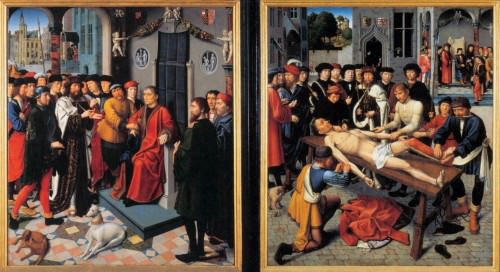
The Judgment of Cambyses
This story is represented as early as in a work from Gerard David (1498) for the main hall of the city hall of Bruges. The aim of this painting in this context was clearly to warn judges, administrators, and other officials and remind them of their responsibilities, and the seat was also a memento for the son of Sisamnes, Otanes. People knew the story and, even if they did not, the image was clear enough. However, the reference to Herodotus as the source of this tale might have not been so well known.

The Judgment of Cambyses
The same scene in a different context takes on a different twist. On the stained glass wall by Dirk Vellert, now at the Rijksmuseum in Amsterdam, for example, the focus is on the flaying only rather than on both the corruption and the punishment as represented by David, in two scenes. Nevertheless, the didactic part of the story is actually the one in which Cambyses puts the young Otanes on the judge's seat. This is also the focus of Rubens' work on this theme in the following century. Of course, the disposition of the skin on the seat is an entirely artistic decision and needs not represent ad litteramHerodotus' tale, which speaks about ἱμάντας (leather strip).
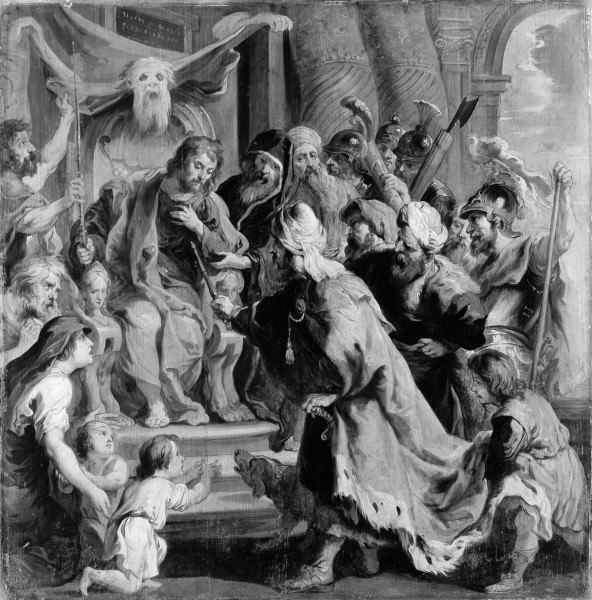
Cambyses Appointing Otanes Judge
One of the stories with the widest range of representations, and certainly one of the most commonly known, is Cyrus' childhood tale. These paintings are based on a mix of versions, including Xenophon 's and several others, which circulated since antiquity, also independently from Herodotus' one. This long tale included several elements and themes that were interesting for painters. The mother of Cyrus has ominous dreams about her future son becoming king so that her father, Astyages, asks Arpagus to kill the baby. Through a series of vicissitudes, the baby nevertheless survives and is brought up by a country lady called “Dog” or directly by a dog, until, through a series of episodes, he is recognized and the prophecy can be fulfilled. With a coupé d'état Cyrus becomes king of Persia and sets the foundations of the Achaemenid dynasty. His chain of incredible successes is brought to an end when he dies at the hands of Tomyris. These stories are often the subject of several scenes and decorative projects.

Childhood of King Cyrus
Often alternative traditions of these tales coexist and are a testimony to the fact that Herodotus' volumes were not always read for reinterpretation and that some stories made their own way. However, it is most certainly Herodotus' tale that directly influences, for instance, the representations of Spako (Dog) kneeling and pointing her finger at the husband's heart.
An extremely famous example of an image which stayed into the mind of any reader or onlooker is, of course, the one of the deeds of Tomyris, Queen of the Messagetae, after she defeated and killed Cyrus:
The greater part of the Persian army was destroyed there on the spot, and Cyrus himself fell there, after having reigned for one year short of thirty years. Tomyris filled a skin with human blood, and searched among the Persian dead for Cyrus' body; and when she found it, she pushed his head into the skin, and insulted the dead man in these words: “Though I am alive and have defeated you in battle, you have destroyed me, taking my son by guile; but just as I threatened, I give you your fill of blood.” Many stories are told of Cyrus' death; this, that I have told, is the most credible. ( Hdt 1.214 Translation by AD Godley from Perseus)
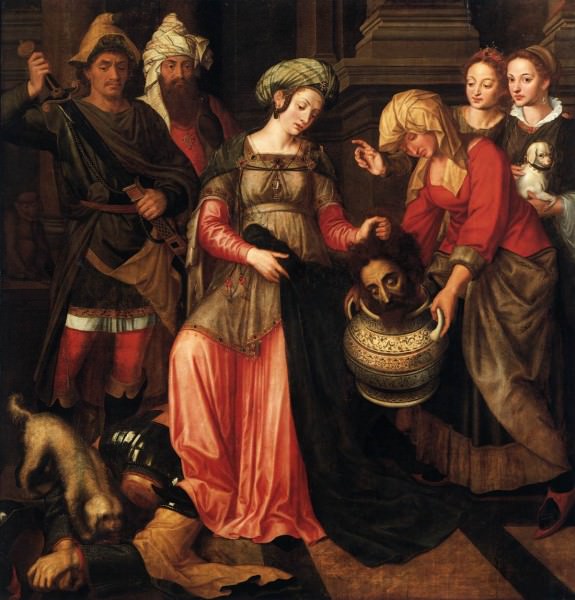
The Revenge of Tomyris
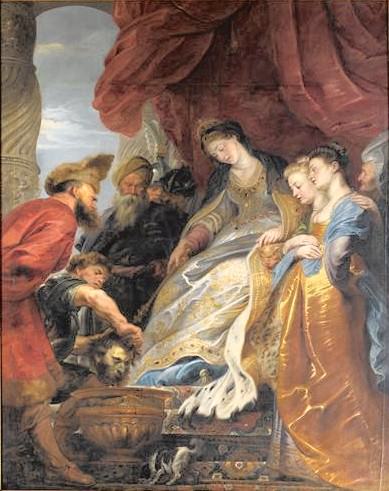
The Vengeance of Tomyris
In the paintings of this scene, interpretations are as many as there can be. Van Coxcie shows us Tomyris while she dips the head of the king in a bowl held by a courtesan. She has a rather vicious look and a foot on the corpse, which is also attacked by a dog. Rubens instead, at least in this example, has in mind also the despair of Herodotus' queen and the contradiction of her victory and successful revenge; therefore, she does not act with her own hands: she is sad and suffering ( ἀπώλεσας ) and holds onto the throne, on the verge of crying. Here we can think that the author knows the content of the entire story well enough, not just the theme of the image. However Rubens' approach is almost completely lost in the following centuries, and the queen of revenge takes over the despairing one of Herodotus' story, partly as a consequence of becoming one in a series of profane subjects which were more or less standard.

Babylonian Marriage Market
In the 19th century CE, in the context of renewed explorations of the Mediterranean and with the return of a strong interest in Classics, especially in the historians including Herodotus, a series of scenes never represented before emerges. A relatively well-known example is The Babylonian Market by Long, where there is no doubt about the source of the story. This is a famous passage in which Herodotus describes a curious way of giving a husband to each unmarried girl regardless of her status:
I will now speak of their established customs. The wisest of these, in our judgment, is one which I have learned by inquiry is also a custom of the Eneti in Illyria. It is this: once a year in every village all the maidens as they attained marriageable age were collected and brought together into one place, with a crowd of men standing around. Then a crier would display and offer them for sale one by one, first the fairest of all; and then, when she had fetched a great price, he put up for sale the next most attractive, selling all the maidens as lawful wives. Rich men ofAssyria who desired to marry would outbid each other for the fairest; the ordinary people, who desired to marry and had no use for beauty, could take the ugly ones and money besides. ( Hdt. 1.196, Translation by AD Godley from Perseus)
In the 19th century CE, when the first newspapers started to print series of illustrated novels, which sometimes had the Histories of Herodotus as a first issue, some of these painted stories could be finally traced back, and they continued more and more to provide materials for paintings, new stories, and new works of art. Their power to fascinate remained intact and able to generate, until today, uninterruptedly and in heterogeneous ways, thoughts, images, and ideas.
***
A list of paintings with scenes from Herodotus' Histories:
- Battle between the Athenians and the Persians (1463) by Apollonio di Giovanni, depicting Hdt. 7.20f. : Online at http://fe.fondazionezeri.unibo.it or http://www.oberlin.edu/amam/Giovanni_Battle.htm
depicting Hdt. 3.125. Online http://www.artic.edu/aic/collections/artwork/44829
LICENSE:
Article based on information obtained from these sources:with permission from the Website Ancient History Encyclopedia
Content is available under License Creative Commons: Attribution-NonCommercial-ShareAlike 3.0 Unported. CC-BY-NC-SA License